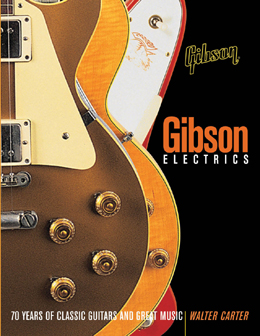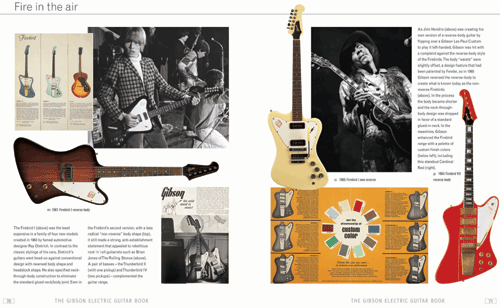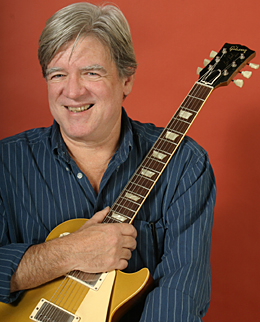by Tom Watson.
 |
|
The Gibson Electric Guitar Book by Walter Carter |
You would be hard pressed to find someone more qualified to tell the Gibson electric guitar story than Walter Carter. The author of several well known and respected books about guitars, Carter has been a keen Gibson observer for over 20 years from a unique perspective – as both a company insider and an outside chronicler of the Gibson story.
The Gibson Electric Guitar Book (Backbeat Books) succinctly recounts the Gibson saga from the company’s beginning through today. While Carter’s previous 308-page book on Gibson, Gibson Guitars: 100 Years of an American Icon, is a must-have reference and enjoyable read, the new 160-page book condenses the Gibson story down to 60 pages of text without sacrificing important detail or behind-the-scenes color.
The focus here is on Gibson electric guitars. Despite its rich history with acoustic guitars, banjos, mandolins and its entry into a variety of other musical instrument markets such as the piano (Baldwin), drums (Slingerland) and music delivery systems (Wurlitzer), Gibson’s electric guitar models account for the company’s longevity and market status. Carter’s telling of this tale reveals the heart and soul of the seven-decade history of the Gibson electric.
The presentation provides a convenient read, delightful eye candy and a handy reference guide to the electric models. The majority (120 pages) of the book alternates between two-page text and two-page photo-based spreads, an interesting approach that gives the reader the option to focus on the story line without image distraction.
 |
|
Two page photo-based spread from The Gibson Electric Guitar Book by Walter Carter |
The story winds its way chronologically through the major Gibson “periods”: pre-World War II; Ted McCarty; Norlin; and, from 1986 through the present, Henry Juszkiewicz. Carter draws on both his 20 years of extensive research that gave birth to previous books (three co-written with George Gruhn: Gruhn’s Guide To Vintage Guitars [1991]; Acoustic Guitars & Other Fretted Instruments [1993]; Electric Guitars & Basses [1994]; and Gibson Guitars: 100 Years Of An American Icon [1994], which he wrote while working for Gibson) and fresh inquiries for this book that bring to light new detail (this is especially true of the often overlooked or derided Norlin period). But, what so uniquely qualifies Carter to tell this story is the fact that he worked for Gibson’s corporate marketing group for a total of nine years (two stints, the second ending in 2005 when he left to re-join George Gruhn at Gruhn Guitars) during the current Juszkiewicz period, which may well be the most fascinating era of the Gibson tale to-date.
Following the text and photo-based spreads is a reference section with specific model information, which serves well as a handy guide to most Gibson USA and Gibson Custom, Art, and Historic electric guitar production models through 2007. Looking for the specs of the short-lived (1985) Gibson Q models? Did you know the reason why the 1983 map-shaped Gibson is so rare is that they were produced as promotional models for dealers? The 29-page reference section is an invaluable tool for anyone needing quick access to Gibson electric guitar model specifications.
The Gibson Electric Guitar Book, however, is about much more than model facts and figures and will appeal to a variety of readers. Yes, to those of us who have a love affair with electric guitars, no fact or figure is too trivial when it comes to the objects of our affection, and the book serves as an information love fest; but, Carter understands that at its heart, the Gibson electric guitar story is about the people who make and play the instruments. As a collection of people stories that reveal defeat and victory, idiosyncrasies and vision, Carter’s narrative engages from start to finish.
Walter Carter spoke to Guitar International about The Gibson Electric Guitar Book on November 20, 2007, from his office at Gruhn Guitars in Nashville, Tennessee.
 |
|
Walter Carter |
Tom Watson: Why this book? What was the inspiration?
Walter Carter: It’s a book that the publishers, Tony Bacon and Nigel Osborne, had in mind and they approached me to do it. I had done another book for them, The Martin Book.
Tom: Any idea why they thought there was a need for another telling of the Gibson tale?
Walter: [Laughs] There are parts of the tale that hadn’t been told yet and it hasn’t been told in its entirety, in any book that I know of, in this much detail. That’s why I think they thought it would be a viable project.
Tom: Why specifically Gibson electrics and not just the Gibson story?
Walter: As a large scope project, the Gibson story in general has been told in the book that I did for Gibson [Gibson Guitars: 100 Years Of An American Icon]. The Electric book is focused for an audience that just wants to hear the stories behind those guitars without putting the company into complete historical perspective as I did in the Gibson book in which for each era of the company there’s a separate chapter on what was going on in the world at that time and then what was going on in the music business at that time. I think you can get your arms around the Gibson Electric book more easily than you can around the whole Gibson story.
Tom: In this book you tell the Gibson story in 60 pages of text. No mean feat.
Walter: Well, that was the requirement for the text.
Tom: It has to be a little frustrating trying to write a comprehensive snapshot of Gibson electrics. As soon as you put the book to rest, Gibson comes out with more models.
Walter: [Laughs…Sighs] Well, yes, they come out with more models, but as I said to sort of close off the book, most of Gibson’s models now are variations on a theme. I think that’s going to be true of almost any guitar company. I don’t think anyone can imagine anything that’s very different or innovative. Gibson’s just put self-tuning tuners in a guitar…
Tom: …the Robot…
Walter: …and whether that’s a gimmick or an innovation remains to be seen. It’s not frustrating that it came out right after my book was published. I’m not worried about missing that. The story continues and somebody else will pick it up.
Tom: What is it about this book that should entice readers to buy it?
Walter: First of all, it’s a continuous story that starts in the ’20s and goes all the way through today. Gibson’s now one of the longest established companies in the music instrument industry, but that wasn’t the case when they started making electric guitars and it’s interesting to understand the challenges they’ve faced.
That the book is an overview with details would be the best way to describe it. You get inside model and company information and detail without ever losing sight as to where you are in the big picture of the development of musical instruments and popular music.
Tom: What’s some of the new information or some of your favorite tidbits?
Walter: There’s information from an interview with Scotty Moore that I don’t think people have heard before – Scotty was Elvis’ guitar player – and I tried to delve a little more into the ’70s, which is a period that collectors haven’t paid much attention to. I spoke to Jim Deurloo, who’s with Heritage Guitars now, and he contributed quite a bit of information, sort of filling in holes of information during that period. And I spoke to some other people about that period – Tim Shaw who was making pickups for Gibson and who was instrumental in bringing the pickups back to the ’50s specifications.
I think some of the details of the current era, which started in 1986, which means the current owners have been there over 20 years now, not all of that was known and I was there [at Gibson] through a fair amount of that, so you get an insider’s view of some of the things that went on.
Tom: You’ve spent time with Henry Juszkiewicz.
Walter: Yes, I have.
Tom: What’s he like?
Walter: Henry’s pretty much what people perceive him to be. He can be erratic, he has an MBA from Harvard – I think people know what that means in terms of self-confidence, let’s say. He’s very driven to make his mark in the business world with Gibson. He has great vision but, often, unfortunately, not always the resources to support that vision or to implement his vision. But, I think the vision has always been correct for the growth of the company. He sees Gibson as a huge, worldwide icon and lifestyle type of company and his vision is bigger than his wallet at times.
Tom: How does he fare with guitar players? Put a Harvard MBA in a room full of guitar players and how does that work out?
Walter: Oh, he plays a little bit. There have been people that have run Gibson that didn’t play at all. Ted McCarty didn’t play guitar and Guy Hart, the person Ted McCarty succeeded as the general manager of Gibson did not play guitar. Henry’s not a great player but he gets up and jams with people who are great players.
Tom: Is he a good listener?
Walter: It depends upon the situation. He has his own opinions and they’re sometimes formed from what other people have told him and a lot of them are his own opinions. He’s certainly confident in his own opinions, in his own ability to analyze and market and to know what’s needed.
Tom: Does he have a good feel for Gibson’s history?
Walter: Not really, but to a point where it’s useful for Gibson’s growth now. He’s certainly not caught up in Gibson history.
Tom: Does Gibson maintain an historical archive?
Walter: There are some instruments and some archival materials that are in various places in the company. It’s not well organized; it’s not curated by any means.
Tom: I had the impression during your time with Gibson that you were the curator.
Walter: Well, I was, as much as I could in terms of not throwing away things and keeping materials organized and in one place. I think you’ll find that most other guitar companies have no archival organization either.
Tom: Does Gibson have a policy about keeping historical instruments and documents?
Walter: No. Like most companies, they always feel like they have to sell everything they make. [Laughs] They don’t put very many instruments aside. I think people have the idea that they hold one back every time they make a new model but that’s not the case at all. In terms of documentation, there are computer records in terms of sales, but things like price lists and catalogs, there’s no regular or official program or orders to keep those materials. If you look at many of the old price lists, they say “destroy all previous price lists.” Companies don’t always want their earlier documents out there.
So, the things that get saved are saved by people in positions like I was with Gibson as editorial director or the designers who design the catalogs. The marketing department would keep files, but those might get thrown away under new regimes. There was no systematic plan to archive things.
Tom: Did you work with Gibson in preparing this book?
Walter: No, other than talking to some people at Gibson. For the scope of this book, I didn’t feel I needed to have their cooperation. I was there for a fair amount of the time during the modern era.
Tom: What did you draw upon for your historical research?
Walter: Most of it came from research I’d done for other books and there are other sources out there too. I mention Andre Duchossoir’s book [Gibson Electrics: The Classic Years] in the acknowledgments. I think anything anybody does for Gibson electrics starts with that as a foundation. His research was so early and so thorough everybody needs to acknowledge the groundbreaking work that he did. Otherwise, it was the research I’d done over the last 20 years.
Tom: From your archives.
Walter: Yes, from things I had personally. I don’t know that I used the Gruhn archives so much for this particular book, but the work that I had done for say, Gruhn’s Guide, was invaluable.
And I mention this in the acknowledgments too – just the day to day flow of instruments through Gruhn Guitars is a gold mine of opportunity to learn about them.
Typically, catalogs, price lists, advertising and marketing materials are not 100% accurate.
Tom: Books like The Gibson Electric Guitar Book are great reference tools, especially for information about the more obscure models. I don’t know how many times I’ve spoken to a player who mentions a model I’ve never heard of or can’t recall off the top of my head.
Walter: It’s tough for us, too. In the day to day business here [Gruhn Guitars] we get recent instruments in and go, “What the hell is this?” [Laughs] It’s difficult to find accurate information. Sometimes it was even difficult for me when I was with Gibson to get that information from the various manufacturing divisions. Detailed information wasn’t always public or even available within the company on all the projects they were working on.
Tom: I’m sure you interviewed Ted McCarty somewhere along the line.
Walter: Yes. Where I quote him it’s from interviews I did while preparing the Gibson 100 Years book.
Tom: What sort of person was he?
Walter: Oh, he was gregarious, also driven to make his mark, a very friendly type of person but who I think was tough to work for, or fair but tough to work for. It was a very competitive time when he was at Gibson. He seemed like a very straightforward and plain-speaking individual. You could certainly trust him and I found him to be very likable.
Tom: What’s your take on the strength of Gibson’s position today?
Walter: I think Gibson is as strong as ever today. Other than Fender, and Martin in the acoustic arena, no one has the brand strength, the worldwide recognition and reputation that allows them to charge more for a Gibson than other companies can get for an equivalent guitar. Part of that is the brand, and the prestige of having a Gibson and the reputation that it is going to be a great guitar.
Tom: What did you think about the digital Les Paul?
Walter: I thought the digital never quite hit the mark, and I think the mark was that people wanted a guitar that they can plug directly into their computer. The [Gibson] digital guitar’s output ended up analog – you can have six different analog signals, one for each string, but that has nothing to do with being digital. That’s an analog pickup that was developed much earlier than the actual digital guitar – the pickup dates back to the early ’90s. It was described in one review [Wired] as a solution without a problem, or something to that effect, and until an artist finds something new that he can do with the digital guitar that he can’t do with a conventional guitar, then the digital guitar’s going to remain a gimmick. On the other hand, if all of a sudden it finds its way on to a hit record with a new sound, then it will be the next big thing.
Tom: Would you say that over the last 20 years it’s been the personality of Henry Juszkiewicz that’s brought Gibson to its current position of strength?
Walter: Oh, I’d say Henry’s personal strength and drive definitely propel the company. I think almost anyone else in that position would have been content to be a successful instrument-making company, and Henry’s not content with that.
Tom: We keep a close eye on Gibson and see the company associated with things such as a polo team and a lingerie company – a very aggressive marketing and branding effort.
 |
|
Walter Carter |
Walter: All of that sort of marketing is strictly Henry. The actual corporate marketing department had no involvement in those things at all except to publicize them when they happened. It wasn’t part of a corporate marketing scheme, that was Henry’s personal marketing scheme.
Now, some of the things are an outgrowth of the entertainment relations offices and the contacts that those people have. In the case of the polo team, there was a fellow in the London office who had that connection. With respect to Fashion Week, there are people in Gibson’s New York office who have connections there, but these things are 100% the result of Henry and his vision.
Tom: Related to lifestyle branding.
Walter: Yes, and again, that’s 100% the result of Henry’s vision.
Related Links
The Gibson Electric Guitar Book on the Backbeat Book Website
Gruhn Guitars
Gibson Guitar
Related Articles
The Gibson Digital Guitar Comes to Market: A Talk with Henry Juszkiewicz
Gibson’s Robot Guitar Includes Advance in PowerTune System